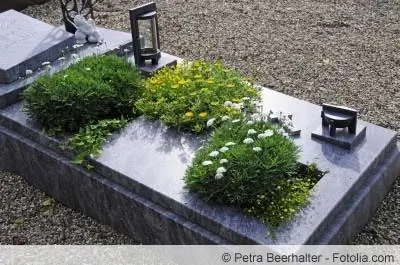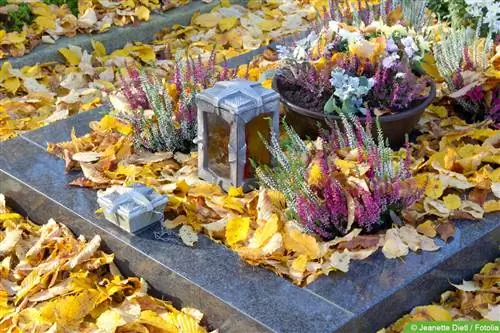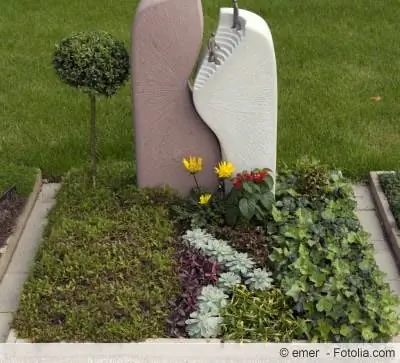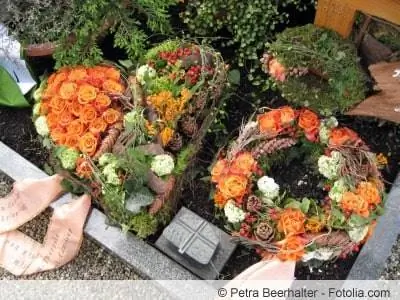- Author admin [email protected].
- Public 2023-12-17 03:39.
- Last modified 2025-01-24 12:45.
Depending on the location of the grave, it may be necessary to select grave planting that is particularly easy to care for. It's not always possible for someone to stop by regularly to water, pull weeds or prune. Anyone who takes such considerations into account when designing the grave and planting it will be able to visit a tasteful, beautiful final resting place for a loved one at any time for years to come. The design of an easy-care grave site needs to be well planned. The limited space and the local location are other important factors for planning.
Burial mounds
Immediately after the burial there is a burial mound. Only after about four to six months will this have sunk to such an extent that the grave can finally be designed and planted. How long this takes in each individual case depends entirely on the weather conditions and the nature of the soil. During this initial period you can place seasonal plants on it or simply leave the hill empty and wait for the soil to form a level surface with the surrounding area.
Cemetery regulations
In many cemeteries there are certain rules for the design of a grave. You want to give the cemetery as a whole a calm and harmonious look. The regulations can range from the size of the gravestone to the planting for the respective seasons. Inquiring about this with the cemetery administration in advance can save a lot of extra work and hassle afterwards.
Planning
If the gravesite is ready for the initial planting, the following factors must be taken into account when planning:
- Cemetery regulations
- Gravestone and existing room
- Season
- Preference for certain plants (deceased, relatives)
- Location (full sun, shade, partial shade)
- Soil texture (moist, dry)
- Plant care effort
- Watering option
First planting
Designing an easy-care grave is all about choosing the right plants. After all, they will serve as a permanent source of structure for years to come. To ensure that a grave site looks well-kept without too frequent and intensive gardening, you should leave as little free floor space as possible. The less open space remains, the less quickly the soil dries out. This also keeps the weeds in their place. For these reasons, it is advisable, for example, to choose an evergreen ground cover to design the basic structure. The ground cover plants should be selected depending on whether the location is shaded by trees or exposed to the blazing sun. In cemeteries, the graves are often shaded by old trees.
Suitable ground cover forshady locations are for example:
- Fat Male (Pachysandra terminalis)
- Ivy (Hedera helix)
- Cotoneaster (Cotoneaster dammeri)
- Ysander (Pachysandra terminalis)
- Hazelroot (Asarum europaeum)
- Star moss (Sagina subulata)
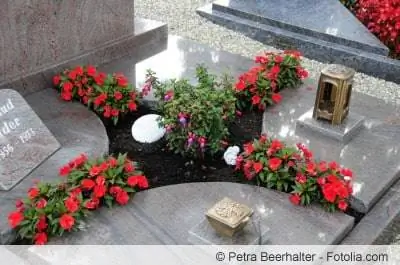
Forsunny locations the following ground cover plants are suitable:
- Blue periwinkle (Vinca minor)
- Cotoneaster dammeri)
- Carpet juniper (Juniperus horizontalis)
- Ground cover roses
- Sand thyme (Thymus serpyllum)
- Andean cushion (Azorella trifurcata)
- Little Lady's Mantle (Alchemilla erythropoda)
- Creeping juniper (Juniperus horizontalis)
- Woll-Ziest (Stachys)
Tip:
Can you only rarely take care of the gravesite and is it exposed to the sun all day? A ground cover made of beautiful pebbles as a base, combined with sun-accustomed potted plants, is a simple way to make a grave attractive and stylish even in the blazing sun.
The following questions can also be helpful as a decision-making aid for an easy-care first planting:
- Can further care be taken over by relatives and to what extent?
- Is grave care commissioned?
- Is an addition desired depending on the season (spring, summer and autumn planting) or is it even a requirement?
- How much is the budget for planting or grave maintenance?
Tip:
Even if you decide to care for the grave yourself, it can be helpful to consult a cemetery gardener before planting. He knows the nature of the local soil and has probably seen many plants come and go there.
Planting time
If the time of initial planting falls in winter, you should wait until spring to plant. In the winter months, the grave is best covered with pine branches or brushwood. Flower bowls or arrangements can decorate the grave during this time. Covering the bare ground in winter also ensures that the soil provides a good breeding ground for the new plants in spring.
Otherwise, depending on the plants you choose, you can actually start planting the plants the rest of the year. However, the best season for this is autumn. Especially for ground cover plants and hedge plants for divisions and borders or small trees.
Design, examples
The following are some easy-care ideas for designing a gravesite. The right proportions are important, especially in a very limited space. The height of the ground cover, the enclosing and dividing hedges and trees should ultimately harmonize with the size of the gravesite and the gravestone.
Easy-care design with small trees
Yew, thuja, boxwood or juniper can be kept in good shape and are also extremely easy to care for. They can create a calm background when placed next to the gravestone. If you like, you can have them cut into simple ball or cone shapes.
Dwarf pines, Japanese azaleas or Japanese ilex make the grave look elegant and tidy at any time of the year.
Structure with a few easy-care perennials
Especially in small areas, you shouldn't plant too many different varieties, as they quickly appear restless and confusing. A nice combination for smaller grave sites is snow heather with cotoneaster and some purple bells in between. Depending on the size, the snow heath can be repeated in the front part. On the right or left, a low, robust floribunda rose with a long blooming period can refine the overall picture. Suitable rose varieties include small shrub roses:
- heather dream
- The Fairy
- Summer Wind
These roses can also be combined with lavender in the classic way, like in the garden. This creates a romantic, harmonious picture for the longest time of the year. The maintenance effort is very low.
Tip:
If you want to plant ground cover roses, you should keep in mind that over time they can grow quite a bit and cover everything.
Seasonal plant selection

Some tips for choosing ground cover to give the grave a harmonious and at the same time easy-care structure have already been listed in the “Initial planting” section. In addition, seasonal, easy-care and, above all, flowering plants are ideal.
Spring
In spring, colorful early bloomers such as crocuses, hyacinths, daffodils and tulips can brighten up the still dreary surroundings. Horned violets, pansies and forget-me-nots are particularly easy to care for and bloom tirelessly for many weeks.
Summer
In the summer it's about choosing those among the summer bloomers that don't need to be watered every day. Begonias, geraniums, busy lizards and fuchsias survive dry periods better than petunias and daisies. Here it also depends on the location of the grave.
The Mandevilla (Dipladenia) is almost an insider tip and perhaps not known to everyone. It is a colorful enrichment from the sun-kissed parts of the world. It blooms reliably and robustly throughout the summer and into autumn. The Mandevilla can be combined excellently with pelargoniums from the cranesbill family. Both have no problem with occasional dry periods.
Autumn
In October, the decorations for All Saints' Day begin and preparation for winter begins. Small, hardy, undemanding aster and chrysanthemum varieties ensure a colorful autumnal bed. With their delicate white or pink flowers, cyclamen provide a beautiful contrast to evergreen ground cover plants. The small variety is more robust against cold. Christmas roses are even more elegant and frost-resistant. But a vase with cut flowers can also enrich the overall winter picture from time to time.
Conclusion
With easy-care grave planting made from ground cover plants, small, shapely hedge plants or trees, you have an uncomplicated foundation. There is also a large selection of easy-care plants for seasonal splashes of color. If you can't deal with the care or planting of the grave, you can get offers from the cemetery gardening company for the annual care of a grave. The easier the selected plants are to care for, the cheaper the grave care fees will be.

